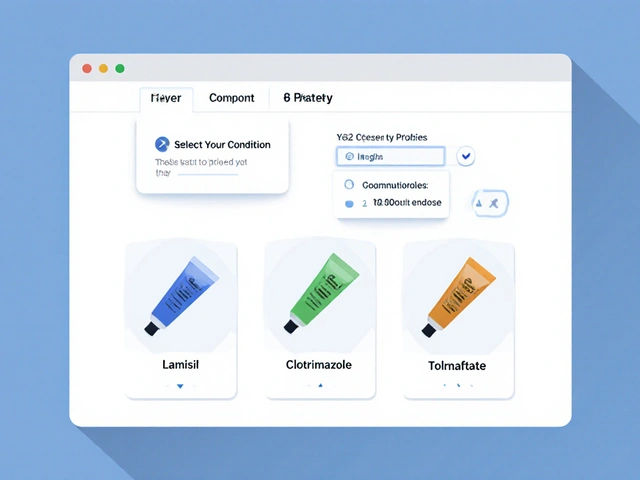Pain Reliever Selector
Enter Your Symptoms and Preferences
Recommended Pain Reliever:
Aleve is an over‑the‑counter medication that contains naproxen sodium, a nonsteroidal anti‑inflammatory drug (NSAID) used for aches, inflammation and fever. When you reach for Aleve, you’re looking for a drug that starts working within an hour and can last up to 12‑14hours, making it a go‑to for stubborn back pain or menstrual cramps. But the market is crowded: ibuprofen, acetaminophen, aspirin, and prescription‑only NSAIDs each claim a niche. This guide breaks down the science, compares the key players, and helps you decide which option fits your lifestyle and health profile.
How Aleve Works - The Science in Plain English
The active ingredient, naproxen, blocks the cyclooxygenase (COX) enzymes that produce prostaglandins, the chemicals responsible for pain and swelling. By inhibiting both COX‑1 and COX‑2, Aleve reduces inflammation while also offering analgesic relief. The longer half‑life (about 12‑17hours) explains why you can take it twice a day instead of every 4‑6hours like some rivals.
What Is an NSAID?
Nonsteroidal anti‑inflammatory drug (NSAID) is a class of medicines that relieve pain, lower fever, and decrease inflammation by targeting the COX pathway. Common OTC NSAIDs include naproxen, ibuprofen and aspirin; prescription‑only options add celecoxib, diclofenac and meloxicam. Understanding the class helps you see where each drug sits on the safety‑efficacy spectrum.
Key Players: Quick Facts
Below is a snapshot of the most frequently mentioned pain‑relief alternatives. The table focuses on dosage, onset, duration and typical side‑effects - the data points most people ask about when they compare drugs.
| Drug | OTC / Prescription | Typical Dose | Onset | Duration | Common Side‑Effects |
|---|---|---|---|---|---|
| Aleve (naproxen) | OTC | 220mg every 8‑12h | ~1hour | 12‑14hours | GI upset, headache, dizziness |
| Ibuprofen | OTC | 200‑400mg every 4‑6h | ~30minutes | 4‑6hours | Stomach pain, rash |
| Acetaminophen | OTC | 500‑1000mg every 6‑8h | ~30minutes | 4‑6hours | Liver toxicity (high dose) |
| Aspirin | OTC | 325‑650mg every 4‑6h | ~30minutes | 4‑6hours | Bleeding, tinnitus |
| Diclofenac | Prescription | 50‑150mg 2‑3times/day | ~1hour | 6‑8hours | GI ulcer, liver enzymes ↑ |
| Celecoxib | Prescription | 200mg once or twice daily | ~1hour | 12‑24hours | Cardiovascular risk, edema |
Deep Dive into Each Alternative
Ibuprofen is a propionic‑acid NSAID that provides rapid pain relief.
Ibuprofen’s shorter half‑life means you’ll need to dose more often, but its faster onset (often under 30minutes) makes it ideal for sudden headaches or post‑exercise soreness. It’s less harsh on the stomach than naproxen at low doses, yet the risk of gastric irritation rises sharply if you combine it with alcohol or take it on an empty stomach.
Acetaminophen is an analgesic and antipyretic that works primarily in the brain, not the inflamed tissue.
Because it doesn’t inhibit COX enzymes in the periphery, acetaminophen relieves pain without reducing inflammation. That makes it a good partner for conditions where swelling isn’t the main issue, such as tension headaches or mild fevers. The biggest caution: the liver can’t process more than 3g per day for most adults; exceeding this limit dramatically raises the chance of acute liver failure.
Aspirin is a salicylate NSAID that irreversibly blocks COX‑1.
Aspirin’s unique property is platelet inhibition, which is why low‑dose aspirin is a staple in cardiovascular prevention. For pain, the irreversible binding means the stomach lining is more exposed to acid, raising ulcer risk. It’s also the only NSAID that can cause tinnitus when taken in high doses.
Diclofenac is a phenylacetic acid NSAID typically reserved for prescription use.
Diclofenac offers strong anti‑inflammatory action and is often chosen for arthritis or post‑operative pain when a doctor wants a more potent effect than OTC options. However, it carries a higher chance of liver enzyme elevation and, in some studies, a modest increase in cardiovascular events compared with naproxen.
Celecoxib is a selective COX‑2 inhibitor that aims to spare the stomach.
By focusing on COX‑2, celecoxib reduces gastrointestinal side‑effects for many patients. The trade‑off is a clearer link to heart‑related risks, especially in people with hypertension or a history of heart disease. It’s taken once or twice daily, giving it a convenience edge for chronic conditions like osteoarthritis.

How to Pick the Right Pain Reliever for You
Think of the decision as a simple flowchart:
- Is inflammation the main problem? If yes, lean toward an NSAID (naproxen, ibuprofen, diclofenac, celecoxib). If you need pure fever reduction without swelling, acetaminophen may be sufficient.
- Do you have stomach sensitivity or a history of ulcers? Choose a COX‑2 selective drug like celecoxib, or stick with low‑dose acetaminophen.
- Are you on blood‑thinners or have heart disease? Avoid aspirin and possibly naproxen; discuss celecoxib’s cardiac profile with your doctor.
- Do you need long‑lasting relief? Naproxen’s 12‑hour window beats ibuprofen’s 6‑hour window, reducing dosing frequency.
- Is cost a factor? OTC options (Aleve, ibuprofen, acetaminophen, aspirin) are generally cheaper than prescription NSAIDs.
When in doubt, talk to a pharmacist. They can flag drug‑drug interactions - for example, combining naproxen with ACE inhibitors may raise the risk of kidney issues.
Related Concepts Worth Knowing
Understanding the broader landscape can improve your confidence when shopping for pain relief.
- Cyclooxygenase (COX) enzymes are the molecular targets that NSAIDs inhibit. COX‑1 protects the stomach lining, while COX‑2 drives inflammation. Drugs that block both can cause GI upset; those that are COX‑2 selective aim to spare the gut.
- Gastrointestinal (GI) protection refers to strategies like taking NSAIDs with food or using proton‑pump inhibitors. This matters most for long‑term users of naproxen or diclofenac.
- Renal function is vulnerable to NSAIDs because reduced prostaglandins can lower kidney blood flow. Patients with chronic kidney disease should avoid high‑dose naproxen.
- Cardiovascular risk is linked to certain NSAIDs, especially COX‑2 inhibitors like celecoxib. Monitoring blood pressure while on these drugs is a prudent habit.
Practical Tips for Safe Use
- Take the lowest effective dose for the shortest time needed.
- Never exceed the maximum daily limit printed on the label (e.g., 660mg for naproxen).
- Pair NSAIDs with a glass of water and food to minimise stomach irritation.
- If you need both an NSAID and acetaminophen, stagger them 3‑4hours apart for better pain control without doubling the dose.
- Store all meds in a cool, dry place and check expiration dates; older NSAIDs can degrade and cause skin irritation.
When to Seek Professional Advice
Even OTC drugs can become dangerous under certain conditions. Contact a healthcare provider if you experience any of the following while using Aleve or its alternatives:
- Severe stomach pain, black or bloody stools.
- Sudden shortness of breath or swelling of the face - possible allergic reaction.
- Persistent headache or visual changes - could signal elevated blood pressure.
- Unexplained fatigue or jaundice - signals liver strain.
Next Steps for Readers
Armed with the comparison table and the decision flow, you can now match a medication to your specific scenario. If you have chronic joint pain, a prescription NSAID like celecoxib might be worth discussing with your GP. For occasional muscle aches, an OTC naproxen or ibuprofen likely does the job.
Keep this guide handy next time you stand in the pharmacy aisle - the right choice saves you time, money, and potential side‑effects.

Frequently Asked Questions
Can I take Aleve and ibuprofen together?
Combining two NSAIDs increases the risk of stomach bleeding and kidney strain without providing extra pain relief. If you need stronger pain control, consider adding acetaminophen instead, but keep each drug within its own recommended dose.
Is naproxen safe for people with heart disease?
Naproxen has a slightly lower cardiovascular risk than some other NSAIDs, but it’s still not ideal for patients with uncontrolled hypertension or a history of heart attack. Talk to your doctor before using it regularly.
How does acetaminophen differ from NSAIDs?
Acetaminophen reduces pain by acting on the brain’s pain pathways and lowers fever, but it does not decrease inflammation. Because it doesn’t affect COX enzymes, it’s gentler on the stomach but can damage the liver if taken in excess.
What should I do if I miss a naproxen dose?
Take the missed tablet as soon as you remember, unless it’s almost time for the next dose. In that case, skip the missed one - don’t double‑dose, because higher than recommended levels raise the risk of stomach bleeding.
Is it okay to take naproxen while pregnant?
Naproxen is generally not recommended during the third trimester because it may affect the baby’s heart and the mother’s labor. If you need pain relief while pregnant, discuss safer options like acetaminophen with your obstetrician.




Jo D
September 27, 2025 AT 18:22Wow, another glorified COX‑inhibition saga, because the world definitely needed a deeper dive into naproxen’s pharmacokinetic half‑life paradigm. Sure, the 12‑hour window sounds like a miracle for chronic back pain, but have you considered the GI‑ulcer cascade that follows every OTC binge? The “quick‑onset” hype is just marketing fluff when you pair it with a high‑fat meal and a latte. And don’t get me started on the cardiovascular roller‑coaster-napro‑xen’s risk profile is basically a thrill ride for your heart. So go ahead, pop an Aleve and enjoy the symphony of side‑effects that come free of charge.
Katherine Krucker Merkle
September 28, 2025 AT 16:35Hey, I get the sarcasm, but it’s worth noting that for most folks the GI upset isn’t a daily inevitability-taking it with food can blunt that effect. Also, the longer half‑life can actually reduce overall pill burden, which is a win for compliance. If you’re worried about heart risk, the data suggest naproxen is a bit gentler than some other NSAIDs, though you should still check with your doc if you have pre‑existing conditions. Bottom line: it’s a useful tool when used responsibly.
Mark Quintana
September 29, 2025 AT 14:49i think naproxen is ok for short term use but watch ur stomach. i read that taking it with a meal helps. also dont combine with alchohol.
Taylor Yokum
September 30, 2025 AT 13:02Let’s break down why naproxen (Aleve) can be a solid choice for many people, especially when you compare it side‑by‑side with ibuprofen and acetaminophen. First, the half‑life of naproxen is roughly 12‑17 hours, which means you only need to dose twice a day for most aches. That alone can improve adherence for someone who forgets to take medicine every few hours. Second, the anti‑inflammatory potency of naproxen is a bit stronger than ibuprofen, making it more effective for conditions where swelling is a major component, like arthritis or menstrual cramps. Third, the risk of liver toxicity is virtually nonexistent with naproxen, unlike acetaminophen, which can become lethal at high doses or with chronic use. Fourth, naproxen’s COX‑1 inhibition is more balanced, so while there is a gastrointestinal risk, it isn’t dramatically higher than ibuprofen when you use the lowest effective dose and take it with food. Fifth, for people who need longer‑lasting relief, naproxen’s duration of action (12‑14 hours) beats ibuprofen’s typical 4‑6 hour window, cutting down the number of pills you swallow each day. Sixth, the drug is widely available over the counter, so you don’t need a prescription for most everyday aches, which keeps costs down. Seventh, studies have shown that naproxen may have a slightly lower cardiovascular risk profile compared to some other NSAIDs, though anyone with heart disease should still consult a physician before regular use. Eighth, if you ever need to stack pain relief, naproxen can be safely alternated with acetaminophen on a staggered schedule (e.g., naproxen every 8‑12 hours, acetaminophen every 6‑8 hours) to cover both inflammation and pain without overloading one pathway. Ninth, the side‑effect profile is well‑characterized, so you know exactly what to look out for: mild stomach upset, occasional headache, or dizziness, which are usually mild and transient. Tenth, for chronic conditions, doctors sometimes recommend a lower‑dose naproxen regimen (e.g., 220 mg daily) to maintain anti‑inflammatory benefits while minimizing GI risk. Eleventh, the drug interacts with certain blood pressure medications and ACE inhibitors, so if you’re on those, keep an eye on kidney function. Twelfth, taking naproxen with a proton‑pump inhibitor (like omeprazole) can further protect the stomach lining for long‑term users. Thirteenth, remember that the “OTC” label doesn’t mean it’s free of risks; read the label, stay within the 660 mg daily maximum, and don’t exceed it. Fourteenth, if you have a history of ulcers, consider a COX‑2 selective option like celecoxib, but discuss it with a healthcare professional. Finally, the most practical tip: keep a simple chart at home that lists your pain medication, dose, and timing – that visual aid can prevent accidental double‑dosing and keep you safe while you enjoy effective pain relief.
Taryn Esses
October 1, 2025 AT 11:15Naproxen works fine if you don’t mind the occasional stomach rumble.
Albert Lopez
October 2, 2025 AT 09:29From a pharmacodynamic perspective, naproxen offers a balanced inhibition of COX‑1 and COX‑2 enzymes, thereby providing both analgesic and anti‑inflammatory effects. Nevertheless, its gastrointestinal tolerability is inferior to selective COX‑2 inhibitors, which may be clinically relevant in ulcer‑prone patients. Moreover, the drug’s impact on platelet aggregation warrants caution in individuals receiving anticoagulant therapy. In summary, while naproxen remains a viable OTC option, prescribers should evaluate comorbidities before endorsing chronic usage.
Halle Redick
October 3, 2025 AT 07:42Totally agree with the balanced view-just remember that a little food and a glass of water go a long way with naproxen. Staying positive about managing pain can actually improve outcomes, so keep that upbeat vibe going! If you ever feel unsure, a quick chat with a pharmacist can clear up any lingering doubts.
Erica Harrington
October 4, 2025 AT 05:55Let’s keep the conversation moving forward! Remember, you’re the driver of your own health, and making an informed choice about pain relief is a big win. If you’re juggling multiple meds, a simple spreadsheet can help you track timing and avoid overlaps. Stay motivated, stay safe, and don’t hesitate to reach out for a second opinion when needed.
Patricia Mombourquette
October 5, 2025 AT 04:09Use naproxen only if you accept the risk it brings its stomach is not immune its side effects are real
karl lewis
October 6, 2025 AT 02:22In the grand tapestry of pharmacotherapy, one must recognize that naproxen, while efficacious, occupies a niche that is both temporally extended and mechanistically broad. Its prolonged half‑life affords a reduced dosing frequency, which is a distinct advantage over agents with shorter elimination phases. Yet, the specter of gastrointestinal compromise looms, particularly in the absence of gastro‑protective co‑therapy, demanding a judicious appraisal of risk versus benefit. Moreover, the interplay with renal function cannot be dismissed, as NSAID‑induced alterations in prostaglandin synthesis may precipitate renal hypoperfusion in susceptible cohorts. Thus, a nuanced, patient‑centered approach remains paramount; one that integrates comorbidities, concomitant pharmacologic agents, and lifestyle considerations. 😊
Amy Martinez
October 7, 2025 AT 00:35I hear you on the stomach worries-my aunt swears by taking naproxen with a hearty breakfast and a banana. It seems to keep the nausea at bay while still giving her the relief she needs for arthritis flare‑ups. Just remember to listen to your body and pause if anything feels off; your health is the most important thing.